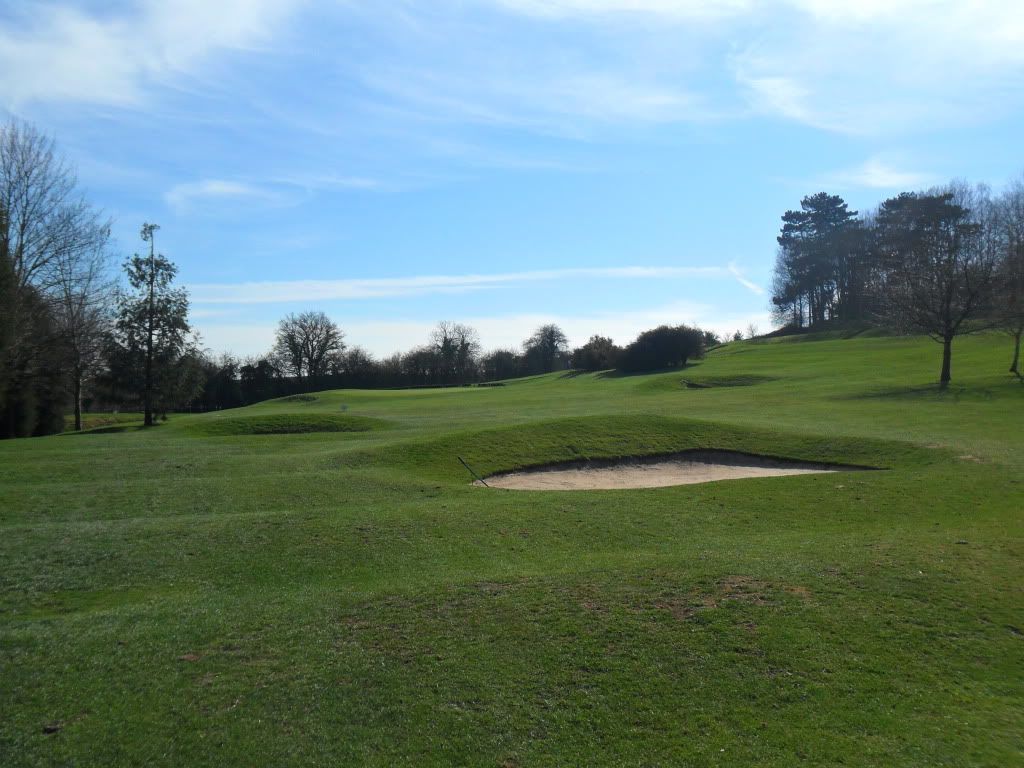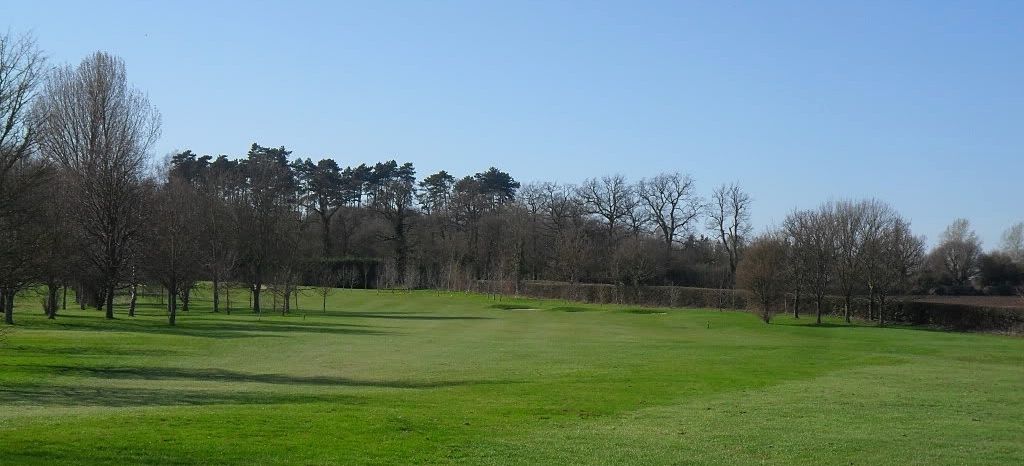Droitwich is a modest club about 20 miles south of Birmingham and is a poster boy for what I would call the average course in England. I used to be a member, but resigned some four years ago. The course was originally designed by a chap called Cawsey, but Braid did an extensive redesign when he expanded the course to 18 holes in 1923. There have been many changes to the course since then, but many of the best holes are the work of Braid. Much of the rest of the course was created by Hawtree & Co. in his 1980s redesign. Notably, the 17th and 18th holes, both very good, were designed by then club pro Ben Croydon in 1938.
The 1st is a drivable par 4. Below is the approach after a 200 yardish layup; notice the ridge running through the middle of the green.

The fairway of the par 5 second leans a load to the right so the drive plays much narrower than appears. The approach over an old marl pit - the namesake for the hole.

A closer look at the green which falls away from the fairway.

Other than the hopeless 11th, the par 3s at Droitwich are quite good. Even so, the 3rd could possibly be made better by placing a cross bunker perhaps 25 yards short and online with the ramp up to the green. Shudder all you strategic thinkers!

The 4th is a tough par 4 turning against the lay of the land. The approach to the three-shot 5th after a long layup.

The next hole threads between water right and oob left. The green too sits close to the boundary making any slightly pulled approached most likely a goner.

#7s and 8 are not bad holes, but don't work that well back to back as both are short par 4s. The driveable 8th is the more interesting of the two as it slants toward oob down the left. For the greedy there is also the unique feature of a cement path long and left of the green which feeds the ball oob (one of my many issues with those in power!). I think this hole is better as a one shotter from the ladies tee. In fact, I think a few shots could be shaved off par by also calling the second a par 4. Instead, as is the want of clubs to pursue the disease of distance, the grandees would never contemplate losing 100 yards and two shots off the card.

#9 takes us back to the house. This too is another point of contention for me. Using this numbering system (solely for the purpose of two nines) means crossing a road four times and a few horrendous walks. I said many years ago that there is no reason to increase the odds of somebody being killed by a racing car (the road to be crossed is a rat-run). The course could simply be re-numbered and there are still two starting points near the house. The end result was somebody was struck and killed by a car, not long afterwards I resigned from the club.
The house.

#10 is a good hole, yet another which is driveable for flat bellies (I reckon fully seven par 4s can be driven by very good players), but for the likes of me there is plenty of interest.


#12 turns hard right and journies once again to the top of the hill. The integrity of this hole has been compromised by the planting of trees and growing of nasty rough on either side of the fairway's turning point - what a shame and yet another reason why I left.

If you hadn't noticed by now, Droitwich features a rather large hill in the middle of the course which dictates bounce/roll and causes wind to change direction several times in a round. Below is the awful 13th.

The uphill/sidehill 425ish yard 14th is a good and tough. Most have to hit a cut, but the flat bellies just hit a draw over the right trees. The approach after a layup.

The uphill/sidehill 15th is another excellent uphill par 3. #16 is a sub 300 yard two-shotter which I have a lot of time for and features a cool name - Tomkins Plateau. The approach after a lay up. The centre bunker is new; I think it should have been put in ~30 yards short of the green.

We now walk what seems a mile to the 17th - a walk which can be avoided if the holes were re-numbered! Despite my misgivings, this is a grand hole. There is a turbo boost around the corner if the player can land his drive about 240ish just on the right edge of the fairway. The short finisher is a tough green to hit because of the left to right wind combined with a narrow green - photo taken not far short of the green.

One can readily see that Droitwich has a lot of issues holding the design back, not least of which is crude bunkering which could use a re-design both in placement and style. Despite several changes which have not benefited the course, the club has made great strides concerning drainage the past several years and now Droitwich is one of the best draining courses in the area. The greens are flatish, but putting is greatly effected by the hill. The course plays best when it is f&f as ball control around the hill is difficult, but fun. The great shame is the terrain for a very good course is there and there are some very good holes. Unfortunately, the entire package merely amounts to an average course.
Ciao